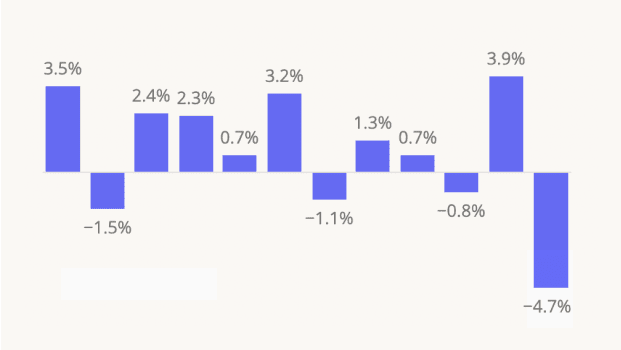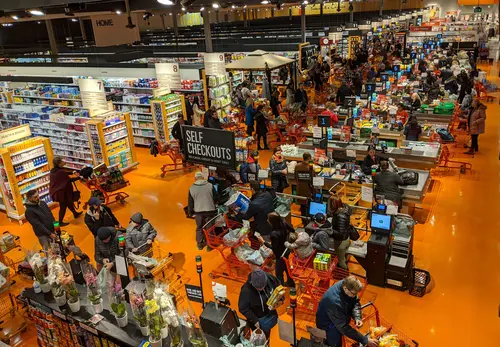Consumer Behavior Amidst Tariff Uncertainty
While the U.S. government has currently partially paused its consideration of reciprocal tariffs on global imports, retailers are still bracing for the possibility of future enactment and potential ripple effects across the industry of the tariffs still in place. From rising supply chain costs to shifts in consumer behavior, tariffs have the potential to impact everything from product pricing to in-store foot traffic. And in an environment where consumers remain highly price-sensitive and economic uncertainty persists, understanding how tariffs could influence retail visitation is critical. While we won’t know the full impact until the tariffs are implemented and impacted retailers adjust, Placer.ai visitation data can help evaluate how the proposed tariffs may be shaping consumer patterns and what that might mean for retailers moving forward.
When new regulations like tariffs are introduced, they often create both short-term and long-term effects. In the short term, consumers remain highly price-sensitive following prolonged inflation in key areas such as food, rent, and healthcare. As a result, our visitation data suggests that some consumers acted early to avoid potential price increases tied to tariff implementation. While visit trends for the week of March 24–30, 2025 were also influenced by the timing of Easter in 2024 (which fell on March 31), Placer.ai data indicates a possible pull forward in demand during the weeks leading up to the expected implementation of the latest tariffs—particularly at “stock-up” retailers like warehouse clubs. In fact, warehouse clubs recorded their strongest year-over-year visitation week of 2025 on the week of March 24-30th, while superstores and grocery stores saw declines, likely due to comparisons to strong performance during the same Easter week in the previous year.
Pre-Tariff Traffic to Discretionary Categories
Looking at more discretionary retail categories, we also see evidence that consumers were trying to get ahead of tariff implementation. Our data indicates that retailers selling products sourced from countries potentially facing higher tariffs experienced stronger year-over-year visitation trends. The timing of Easter 2024 likely contributed to this boost as well—many of these retailers were closed or operating with reduced hours during that week last year. Categories such as home improvement, electronics, luxury department stores, apparel and accessories, and clothing all saw notable year-over-year visitation increases for the week of March 24–30, 2025, as shown below.
Tariff Resilience and Vulnerabilities
While many uncertainties remain around tariff implementation, consumers are likely to increasingly gravitate toward retailers that offer bulk purchasing, strong private label alternatives, and everyday low prices—areas where warehouse clubs and discount grocers with robust private label assortments excel. Similarly, national restaurant chains with streamlined operations, diversified global supply chains, and the ability to scale value-driven promotions will hold a competitive edge. Off-price retailers and thrift stores offering secondhand and resale items may also benefit, appealing to deal-seeking consumers. These types of retailers are often better positioned to absorb rising costs and maintain affordability, making them attractive options in an increasingly inflation-sensitive environment.
Consumer electronics, apparel, luxury goods, and beverage alcohol retailers may be disproportionately affected by potential tariffs due to their heavy reliance on imported products and limited pricing flexibility. Many electronics, luxury, and apparel items are sourced from countries subject to implemented or potential tariffs, which could significantly increase costs in categories already operating with tight margins. For beverage alcohol retailers, tariffs on imported wine, spirits, and specialty ingredients could lead to supply chain disruptions and higher prices, particularly for premium or niche products. In these segments, passing additional costs on to consumers may be challenging in an environment where shoppers remain highly price-sensitive, potentially resulting in decreased demand, inventory issues, and increased reliance on promotional strategies.
Leveraging Data to Navigate Tariff Impacts
As the U.S. moves closer to implementing new tariffs, retailers across categories must prepare for both immediate and long-term impacts. From early signs of stock-up behavior at warehouse clubs to shifting visitation patterns in discretionary categories like apparel and electronics, consumer response is already taking shape. While value-focused retailers and those with operational agility may be better positioned to weather the storm, others – particularly those reliant on imported goods – could face heightened challenges. In this evolving landscape, visitation data can help to assess consumer behavior in real time, helping retailers adapt strategies and remain competitive as the full effects of tariff policies unfold.
For more data-driven consumer insights, visit placer.ai/anchor




.png)
.png)

.png)
.png)












.svg)